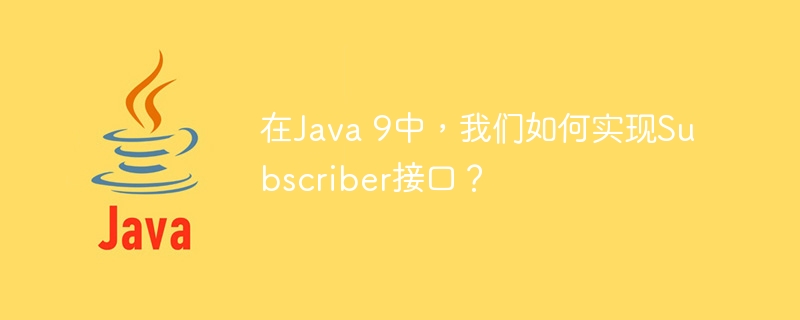How do we implement Subscriber interface in Java 9?

Java 9 supports the creation of reactive streams by introducing some interfaces: Publisher, Subscriber, Subscription and the SubmissionPublisher class that implements the Publisher interface. Each interface can play a different role according to the principles of Reactive Streaming.
We can use the Subscriber interface to subscribe to the data published by publisher. We need to implement the Subscriber interface and provide implementations for abstract methods.
Methods of the Flow.Subscriber interface:
- onComplete(): This method is called when the Publisher object completes its role.
- onError(): This method is called when the Publisher has a problem and notifies the Subscriber.
- onNext(): This method is called when the Publisher has new information to notify all Subscribers.
- onSubscribe(): This method is called when Publisher adds Subscriber.
Example
import java.util.concurrent.Flow;
import java.util.concurrent.SubmissionPublisher;
import java.util.stream.IntStream;
public class SubscriberImplTest {
public static class Subscriber implements <strong>Flow.Subscriber<Integer></strong> {
private <strong>Flow.Subscription</strong> subscription;
private boolean isDone;
<strong> @Override</strong>
public void <strong>onSubscribe</strong>(Flow.Subscription subscription) {
System.out.println("Subscribed");
this.subscription = subscription;
this.subscription.request(1);
}
<strong>@Override</strong>
public void <strong>onNext</strong>(Integer item) {
System.out.println("Processing " + item);
this.subscription.request(1);
}
<strong>@Override</strong>
public void <strong>onError</strong>(Throwable throwable) {
throwable.printStackTrace();
}
<strong>@Override</strong>
public void <strong>onComplete()</strong> {
System.out.println("Processing done");
isDone = true;
}
}
public static void main(String args[]) throws InterruptedException {
<strong>SubmissionPublisher<Integer></strong> publisher = new <strong>SubmissionPublisher<></strong><strong>()</strong>;
<strong>Subscriber </strong>subscriber = new <strong>Subscriber()</strong>;
publisher.subscribe(subscriber);
<strong>IntStream</strong> intData = <strong>IntStream.rangeClosed</strong>(1, 10);
intData.forEach(<strong>publisher::submit</strong>);
publisher.<strong>close()</strong>;
while(!subscriber.isDone) {
Thread.sleep(10);
}
System.out.println("Done");
}
}Output
<strong>Subscribed Processing 1 Processing 2 Processing 3 Processing 4 Processing 5 Processing 6 Processing 7 Processing 8 Processing 9 Processing 10 Processing done Done</strong>
The above is the detailed content of How do we implement Subscriber interface in Java 9?. For more information, please follow other related articles on the PHP Chinese website!

Hot AI Tools

Undresser.AI Undress
AI-powered app for creating realistic nude photos

AI Clothes Remover
Online AI tool for removing clothes from photos.

Undress AI Tool
Undress images for free

Clothoff.io
AI clothes remover

AI Hentai Generator
Generate AI Hentai for free.

Hot Article

Hot Tools

Notepad++7.3.1
Easy-to-use and free code editor

SublimeText3 Chinese version
Chinese version, very easy to use

Zend Studio 13.0.1
Powerful PHP integrated development environment

Dreamweaver CS6
Visual web development tools

SublimeText3 Mac version
God-level code editing software (SublimeText3)

Hot Topics
 Top 4 JavaScript Frameworks in 2025: React, Angular, Vue, Svelte
Mar 07, 2025 pm 06:09 PM
Top 4 JavaScript Frameworks in 2025: React, Angular, Vue, Svelte
Mar 07, 2025 pm 06:09 PM
This article analyzes the top four JavaScript frameworks (React, Angular, Vue, Svelte) in 2025, comparing their performance, scalability, and future prospects. While all remain dominant due to strong communities and ecosystems, their relative popul
 How do I implement multi-level caching in Java applications using libraries like Caffeine or Guava Cache?
Mar 17, 2025 pm 05:44 PM
How do I implement multi-level caching in Java applications using libraries like Caffeine or Guava Cache?
Mar 17, 2025 pm 05:44 PM
The article discusses implementing multi-level caching in Java using Caffeine and Guava Cache to enhance application performance. It covers setup, integration, and performance benefits, along with configuration and eviction policy management best pra
 Node.js 20: Key Performance Boosts and New Features
Mar 07, 2025 pm 06:12 PM
Node.js 20: Key Performance Boosts and New Features
Mar 07, 2025 pm 06:12 PM
Node.js 20 significantly enhances performance via V8 engine improvements, notably faster garbage collection and I/O. New features include better WebAssembly support and refined debugging tools, boosting developer productivity and application speed.
 How does Java's classloading mechanism work, including different classloaders and their delegation models?
Mar 17, 2025 pm 05:35 PM
How does Java's classloading mechanism work, including different classloaders and their delegation models?
Mar 17, 2025 pm 05:35 PM
Java's classloading involves loading, linking, and initializing classes using a hierarchical system with Bootstrap, Extension, and Application classloaders. The parent delegation model ensures core classes are loaded first, affecting custom class loa
 Iceberg: The Future of Data Lake Tables
Mar 07, 2025 pm 06:31 PM
Iceberg: The Future of Data Lake Tables
Mar 07, 2025 pm 06:31 PM
Iceberg, an open table format for large analytical datasets, improves data lake performance and scalability. It addresses limitations of Parquet/ORC through internal metadata management, enabling efficient schema evolution, time travel, concurrent w
 Spring Boot SnakeYAML 2.0 CVE-2022-1471 Issue Fixed
Mar 07, 2025 pm 05:52 PM
Spring Boot SnakeYAML 2.0 CVE-2022-1471 Issue Fixed
Mar 07, 2025 pm 05:52 PM
This article addresses the CVE-2022-1471 vulnerability in SnakeYAML, a critical flaw allowing remote code execution. It details how upgrading Spring Boot applications to SnakeYAML 1.33 or later mitigates this risk, emphasizing that dependency updat
 How can I implement functional programming techniques in Java?
Mar 11, 2025 pm 05:51 PM
How can I implement functional programming techniques in Java?
Mar 11, 2025 pm 05:51 PM
This article explores integrating functional programming into Java using lambda expressions, Streams API, method references, and Optional. It highlights benefits like improved code readability and maintainability through conciseness and immutability
 How do I use Maven or Gradle for advanced Java project management, build automation, and dependency resolution?
Mar 17, 2025 pm 05:46 PM
How do I use Maven or Gradle for advanced Java project management, build automation, and dependency resolution?
Mar 17, 2025 pm 05:46 PM
The article discusses using Maven and Gradle for Java project management, build automation, and dependency resolution, comparing their approaches and optimization strategies.






